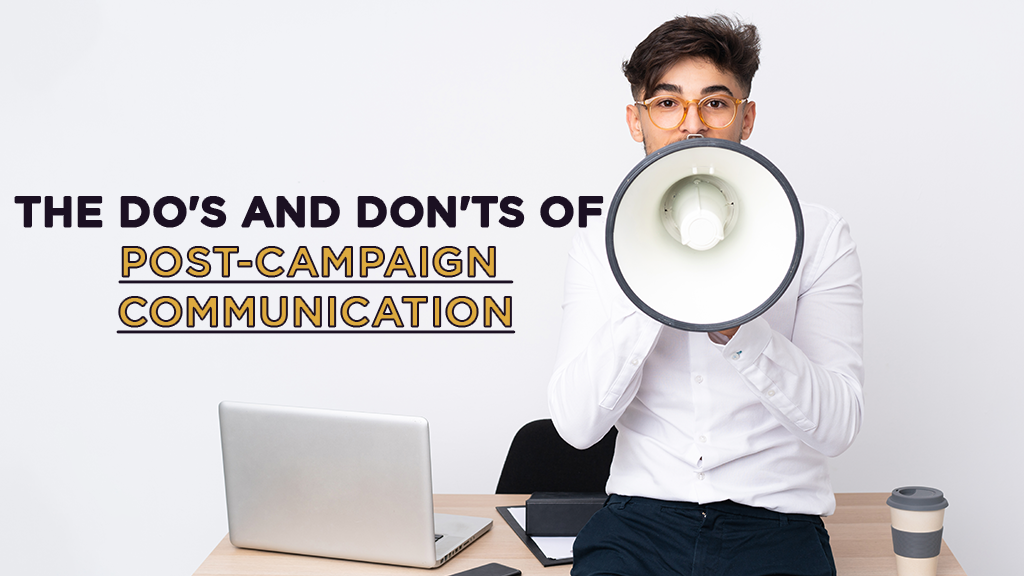
The end of a crowdfunding campaign can be a major sigh of relief, especially if you’ve reached your funding goal. There are many dos and don’ts to be aware of when it comes to an overall successful strategy, but one of the most overlooked aspects is crowdfunding community engagement post-campaign
Until you’ve fulfilled your product to your backers, it’s vital that you make crowdfunding post-campaign communication a priority.
Understanding the importance of post-campaign communication
When it comes to understanding the importance of post-campaign communication, it helps to follow a general rule of thumb: If it affects your crowdfunding campaign, your backers need to know about it. The one thing you never want to do is leave your backers in the dark.
In addition to being transparent, another benefit of effective backer communication is how constant engagement can build your brand and foster a sense of community with your audience. These are important concepts to keep in mind if you have ambitions of building long-term backer relationships and scaling your product into an e-commerce business.
Contents
- Key takeaways on the dos and don’ts of post-campaign communication
- Definition of crowdfunding
- Overview of an effective crowdfunding communication plan
- The dos of post-campaign communication
- The don’ts of post-campaign communication
- Sustaining backer relationships post-campaign
- How to implement this in your campaign
- Case studies and examples of post-campaign communication
- Conclusion
- Further resources
Key takeaways on the dos and don’ts of post-campaign communication
- The four pillars of your communication plan are updates, responsiveness, transparency, and delivery.
- Have a plan in place for crowdfunding backer updates so that there are less oversights in post-campaign transition.
- Employ the Updates feature that’s built into your crowdfunding platform to communicate directly to your backer list.
- The better you engage with your community, the better you can set them up to become long-term customers for your brand.
Definition of crowdfunding
There are some fundamental things about crowdfunding that you need to understand to see the big picture on why post-campaign communication is so important.
Crowdfunding is defined (per Merriam-Webster) as the act of raising money by soliciting contributions from a large number of people. This group of people will be an online community that you can tap into via crowdfunding platforms like Kickstarter and Indiegogo. Over the course of LaunchBoom’s history, we’ve seen how powerful this concept can be.
Where does that power lie? Let’s briefly look at five key concepts that make crowdfunding so effective.
- You can generate revenue without inventory: In traditional product launches, you must have inventory before any kind of transaction can be made. Crowdfunding helps to mitigate the risks involved with manufacturing spending because it lets you raise funds first and fulfill orders later.
- It validates demand for your product: Much of the money that comes out of your pocket in the crowdfunding process is spent on marketing. This allows you to validate the demand for your product before deciding if it’s worth it to heavily invest in design and manufacturing.
- You can position yourself for bigger deals: After a successful crowdfunding campaign, you have a better chance of leveraging that success into positive press and outside investment to help your business grow. This is another often overlooked Indiegogo and Kickstarter post-campaign tip.
- Exposure to a community of early adopters: Crowdfunding platforms like Kickstarter and Indiegogo have passionate communities that seek out new technology, ideas, products. These types of consumers are more likely to stick with budding brands compared to the average e-commerce shopper.
- You have access to honest feedback: The community you build around your crowdfunding campaign will be invested in your success. They can be very loyal if correctly nurtured, as well as generous with constructive feedback. This is crucial to the gradual improvement of your product, brand, and business.
With these concepts in mind, it’s important to keep the final two top of mind as we explore the dos and don’ts of crowdfunding post-campaign communication. Much of it hinges on nurturing this unique audience, and carrying the momentum you build with them to sustain interest after crowdfunding.
Overview of an effective crowdfunding communication plan
Effective backer communication after crowdfunding revolves around the expectations they have of you once your campaign has ended. Think of their expectations as the four pillars of your communication plan.
- Updates: Don’t underestimate the power of simple, regularly scheduled updates. Early adopter audiences get excited to be a part of your journey, so don’t be afraid to give progress updates to keep them engaged.
- Responsiveness: As you ramp up production of your product after your campaign, you’ll undoubtedly be busy. Don’t lose sight of how important it is to check your various communication channels and respond to backers’ questions and concerns in a timely manner.
- Transparency: Crowdfunding comes with a built-in expectation that backers won’t receive what they paid for right away. That being said, don’t lie about delays and setbacks, and certainly don’t make false promises. Transparent communication goes a long way.
- Delivery: The ultimate promise of your campaign is delivery of the product people backed. The battle isn’t won until this step is done.
Importance of communication in crowdfunding success
Think of your crowdfunding backers as customers, and effective communication as good customer service. Until the day they finally receive your product in the mail, you’re walking on a tightrope of trust. Any minor slip up can result in devastating results, so it’s important to stick by the tenets laid out above for successful crowdfunding campaign aftercare.
The dos of post-campaign communication
Building trust after crowdfunding is one of your greatest priorities. Let’s look at the things you absolutely must do in your crowdfunding post-campaign communication plan.
Best practices for engaging with backers
Building trust after crowdfunding starts with implementing these best practices:
Keep replying
Once your campaign is done, backers will likely continue to comment on your campaign page, or Indiegogo InDemand page. Whether you’re seeing a lot of engagement here, or are receiving personal messages via social media or email, don’t stop replying to their comments, questions, and concerns. An efficient way to address common questions is by doing so in the FAQ section available on crowdfunding platforms for all to see.
Be consistent
A key element of post-campaign communication success is being consistent with your backers in both update frequency and tone. Having a consistent voice that keeps in communication with backers will help to build familiarity. It’s not ideal to have them feel like they’re talking to someone new every time they reach out. If you can’t do everything yourself, don’t worry; just make sure to entrust this task with someone who can maintain consistency on your behalf.
Be creative
It’s okay to have some fun with your communication style. Think of it as a chance to engage them on more personal levels. Repetition and consistency are great; staleness and predictability are not.
Consider using different types of content and social media channels as part of your crowdfunding update strategy. For example, try using anything from photos, to short videos, to newsletters, to surveys to keep your backers engaged and informed in different ways.
Have a plan
Planning for this stage of the process can make for a much smoother transition into post-campaign communication. If you haven’t decided on what channels to use, planned for extra help with communication, or allocated the necessary resources, you can find yourself falling behind in responsiveness. Plan ahead to avoid unnecessary delays or confusion.
Be flexible
Even if you have every week mapped out after your crowdfunding campaign, things can still go wrong. As with anything in business, you need to be flexible to adapt to any setbacks you encounter.
A flexible mindset can also be useful for gathering feedback that you can start implementing right away. Try starting an open dialogue with your community of backers in a forum-like platform, such as Discord or Reddit.
Positive communication techniques
As we touched on before, be sure to adopt a positive communication mindset with customer service being your driving motivation. A great way to project positivity is to remember to be grateful and appreciative of your backers’ support. Make gratitude a regular part of your post-crowdfunding communication techniques and deal with any issues with a similar mindset.
Their funding has made a big impact on the life of your product, so don’t be afraid to offer alternatives or compensation when necessary to show that you appreciate the trust they put in you and your campaign. Positive customer experiences go a long way in creating general satisfaction with your brand that can reverberate throughout your entire community.
The don’ts of post-campaign communication
Now that you know about the best practices, it’s important to also know what not to do. Let’s go through some of the don’ts of post-campaign communication.
Common communication mistakes to avoid
Avoid the following pitfalls to maintain good post-campaign crowdfunding etiquette:
Don’t neglect platform updates
Kickstarter and Indiegogo have Updates features built in, which gives you direct access to everyone who has backed your campaign. It’s okay to want to limit yourself to just a couple of communication channels, but the Updates feature on these platforms is a good way to ensure every single backer sees what you need them to. Some useful ways to use the platform updates include:
- Project progress, or delays
- Visual content like pictures and videos of new prototypes, perks, etc.
- Contact information to get in direct touch with you if necessary
Don’t have long pauses in communication
You’ll undoubtedly be busy, but not communicating anything to your backers might create some red flags for them. Even if you have nothing majorly important to share regarding progress, don’t take that as a sign that they don’t need to be updated. At the bare minimum, have something to share with your community once every two weeks. Any communication is better than no communication.
Don’t give backers false hope
It’s tempting to want to set a hard date for yourself regarding when you can finally ship your product. We’ve seen big manufacturing mistakes happen that can end up setting you back from your initial promised date. And instead of giving an update like “Expect products to ship next week,” take a safer approach and only inform backers after the product has shipped. That’s the only way to protect yourself from the blowback caused by false expectations.
You can create progress timeliness or status bars for people to follow, but try to avoid setting even tentative dates of completion.
Don’t forget to add a personal touch
When you stop thinking of backers as just customers, you can see how much they really mean to the success of your crowdfunding endeavors. This community of investors have financial stake and trust in your product, so show them your gratitude by engaging backers after funding with personalized messages whenever communicating one-on-one.
Pitfalls in backer relations
Personal touch aside, it’s still important to strike the right balance when communicating with backers. You never want to get too personal or familiar to where you let people take advantage of you. And vice-versa, you want to avoid the pitfall of getting to the point where you’re starting to take advantage of backers.
Crowdfunding audiences naturally form emotional connections to the products they back, but there’s fragility there. As long as you’re communicative, transparent, and deliver on product fulfillment, you should be able to avoid major blemishes in your post-crowdfunding backer relations.
Sustaining backer relationships post-campaign
We talk a lot about the LaunchBoom crowdfunding framework of “test, launch, scale.” If you’re in the post-campaign phase, you’ve tested and you’ve launched. Now it’s time for the ultimate Kickstarter and Indiegogo campaign follow-up — scaling your business!
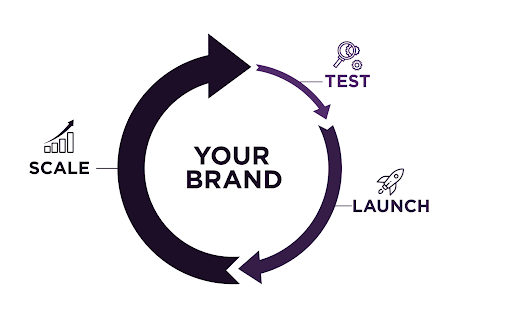
To set yourself up for success in the scaling stage, it helps to practice good backer engagement. The idea is to turn one-time backers into long-term customers when you make your transition from crowdfunding to e-commerce by remaining engaging and sustaining interest after crowdfunding.
Managing backer expectations
As we’ve touched on, crowdfunding backers more-or-less know what to expect when they pledge their money to creators. The battle isn’t over until their product arrives at their door. With that in mind, let’s look at some of the ways this crucial expectation affects you and your communication strategy.
- Comments: The comments sections across your various platforms, including your campaign and Indiegogo InDemand pages (which you definitely should have) will no doubt be hubs of activity. If you don’t have notifications for these turned on, consider doing so, because one or two missed comments can end up sending the wrong message.
- Direct messages: You should have provided your backers with the best way to contact you directly once your campaign ended, so expect to receive direct messages and emails from time to time.
- Questions: Questions will be posted all over the place, so be sure to scour every nook and cranny for ones you may have missed. On top of using the FAQ section of your crowdfunding page, consider also making use of a newsletter that periodically arrives in your backers’ inboxes with the most common questions answered.
On top of juggling the communication driven by backer expectations, it’s essential to other methods of engagement to help foster your crowdfunding community.
Continuous engagement strategies
Engaging backers after funding shouldn’t be looked at as a chore. Here are some ideas that can make continuous engagement enjoyable and beneficial:
Designate a forum for your community
Crowdfunding is a social exercise by nature, so a good strategy for maintaining backer engagement post-campaign is to leverage forums and social media groups. Consider setting up spaces for your audience to interact, such as a Facebook VIP group or a Discord server for your backers. This allows your community to flourish from within.
Be on the lookout for the most prominent supporters in these platforms, because they are the ones who you can help keep others engaged and even lend a hand in crowdfunding feedback management. These backers are your true believers and display responsiveness, generosity, and lots of passion. Reach out to them often, and make sure they are properly recognized for their contributions.
Consider turning to YouTube
And if you really want to go the extra mile, you can consider starting a YouTube channel for your business where you can document and share in video form. This can be a lot of work, but can pay dividends as you drive traffic to your YouTube videos via your multichannel marketing infrastructure. Videos are easily digestible, offer a chance to flex your creativity, and are infinitely shareable to get the word out even more about your product.
How to implement this in your campaign
By reading up on the dos and don’ts of post-campaign best practices for crowdfunding communication, you’re already well on your way to proper preparedness for when the time comes.
To implement the ideas highlighted in this post, start outlining the ways you feel most comfortable you can handle for your communication strategy. You want to make sure you have a mix of at least three different ways you’ll be communicating updates in the leadup to delivery, so start by narrowing down the various channels .
Practical steps for effective communication
You’ll likely be deep in analyzing the post-campaign analytics or taking care of design and manufacturing, but you still need to prioritize communication.
One of the most practical things you can do ahead of time to set your business up for effective communication is put someone that you trust in charge. This isn’t a must — if you feel you can handle it alone — but having an extra set of eyes who can stay engaged with backers in a timely manner can help eliminate any oversights.
On the flipside, you can also put someone else in charge of content and engagement while you worry about backer communication. In theory, you know your product and timelines better than anybody, so it’s helpful to have someone else who can focus on producing content on your various social channels.
Lastly, don’t forget to use the FAQ tabs available on Kickstarter and Indiegogo. As you start hearing repeat questions and feedback from your audience, you can make posts on the FAQ tab on your crowdfunding platform to address common concerns and save time for yourself moving forward.
Integrating feedback and learning
On the subject of feedback, this is one of the great gifts you can receive by exercising good communication after your campaign. We’ve seen creators end up saving thousands of dollars by choosing not to do something they wanted to because of knowledge they gained from backers via their constructive feedback. One of the easiest places to find feedback is on the comments section of your campaign page, which is only available to those who have pledged.
If you find that you’re not getting feedback naturally, though, we recommend that you source your backers for any comments or suggestions they may have. Not everyone is open to sharing their thoughts without prompting. Not only does soliciting feedback build a sense of collaboration in the community, but it makes everyone feel that much more connected to the product they’ve funded.
To collect feedback anonymously, try using one of the many survey tools available out there to generate new learning about anything you feel could benefit from improving. And be sure to always thank your community for their contributions.
Case studies and examples of post-campaign communication
We’ve seen a lot of examples of successful communication in crowdfunding, as well as our fair share of missteps. Let’s look at an example of each, to give you a look at how to build your own foundation for properly engaging backers after funding.
Success stories in post-campaign communication
One of our earliest clients, Give’r, launched their first product on crowdfunding back in 2016 and raised $270,942. Fast-forward to 2019, and Give’r had a brand new product ready to launch. This time around, they raised $986,672 for their Give’r Frontier Mittens on Kickstarter.
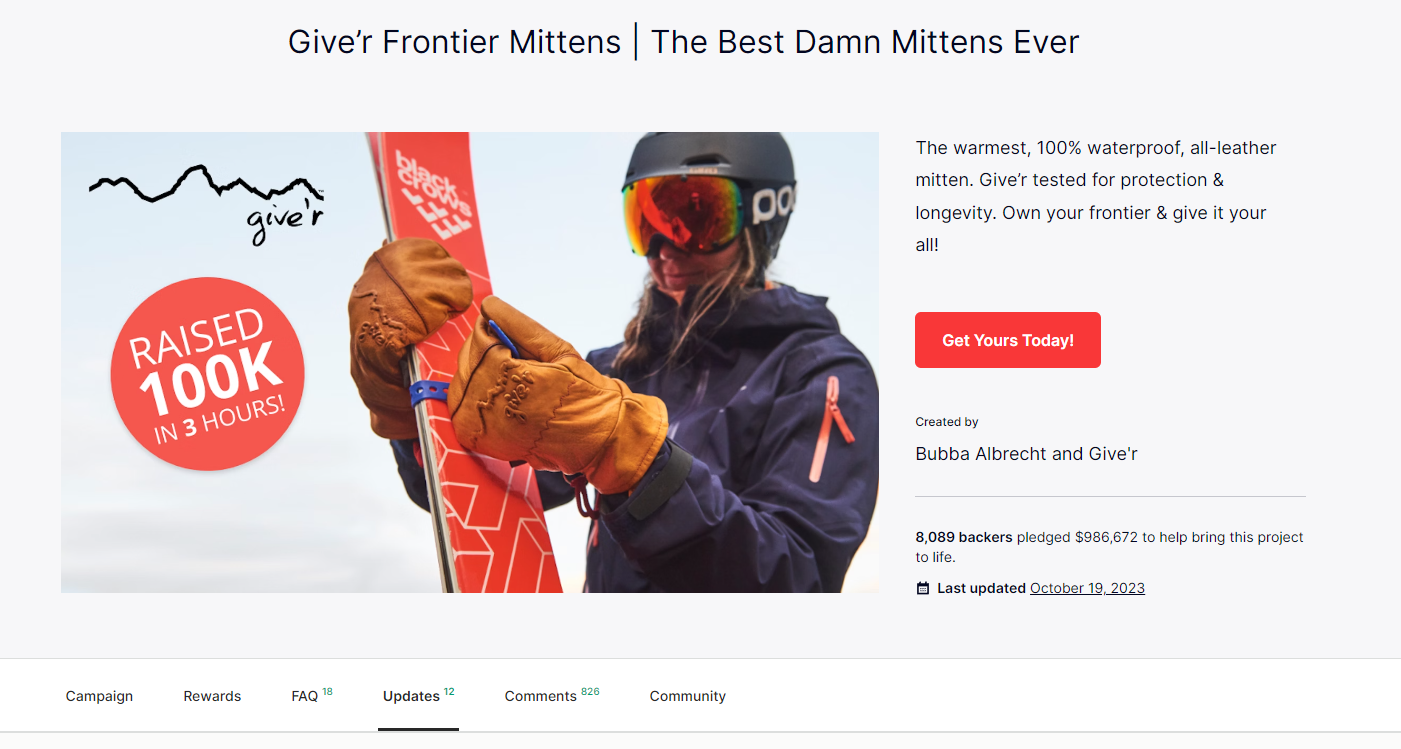
It’s safe to say that excellent post-campaign communication from previous launches played a role in bringing people back to their now trustworthy brand, as proven by the FAQ, Updates, and Comments sections of their Frontier Mittens campaign pictured above.
As we’ve touched on, the Comments section is a crucial forum for discussion where much of your post-campaign communication may occur. For this campaign, their comment section reached up to 826 comments. That’s a lot of engagement! No matter how minor or severe questions were for the creators, the Give’r team did their best to stay communicative with their backers.
One of the other best communication takeaways here is how much activity they continued to get in the Comments section after the product was delivered. Several backers may voice their dissatisfaction after receiving something that didn’t meet their expectations, but you should never take this as a sign to panic.
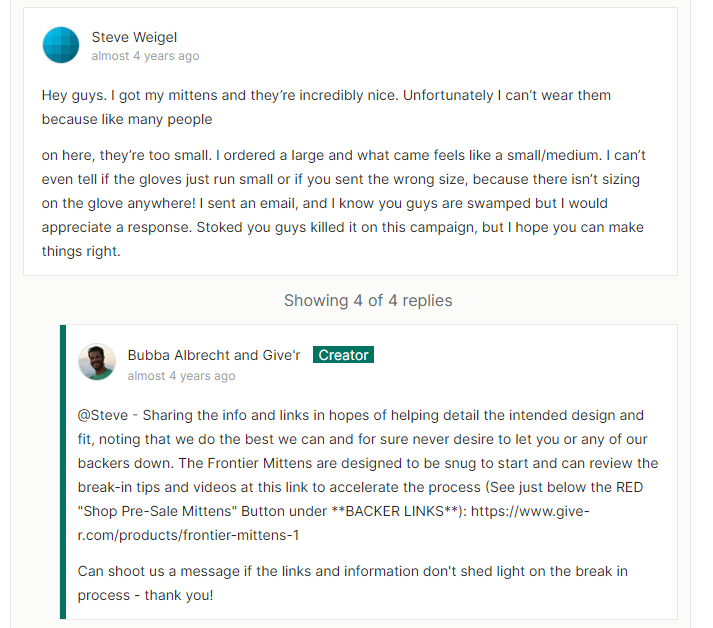
Like with Give’r, maintain open communication, be transparent, and do your best to address people’s concerns to make sure they feel heard. The more proactive you can be about putting out fires, the more likely backers will be to stick with you in the future.
Today, the company Give’r has evolved into a healthy e-commerce business selling the products that helped to put them on the map through crowdfunding.
Lessons learned from communication failures
One of the most important aspects of backer communication is making sure you don’t come across as a scam. People on Kickstarter and Indiegogo have been burned in the past, and the iBackPack campaign is a prime example of what not to do to lead your backers astray.
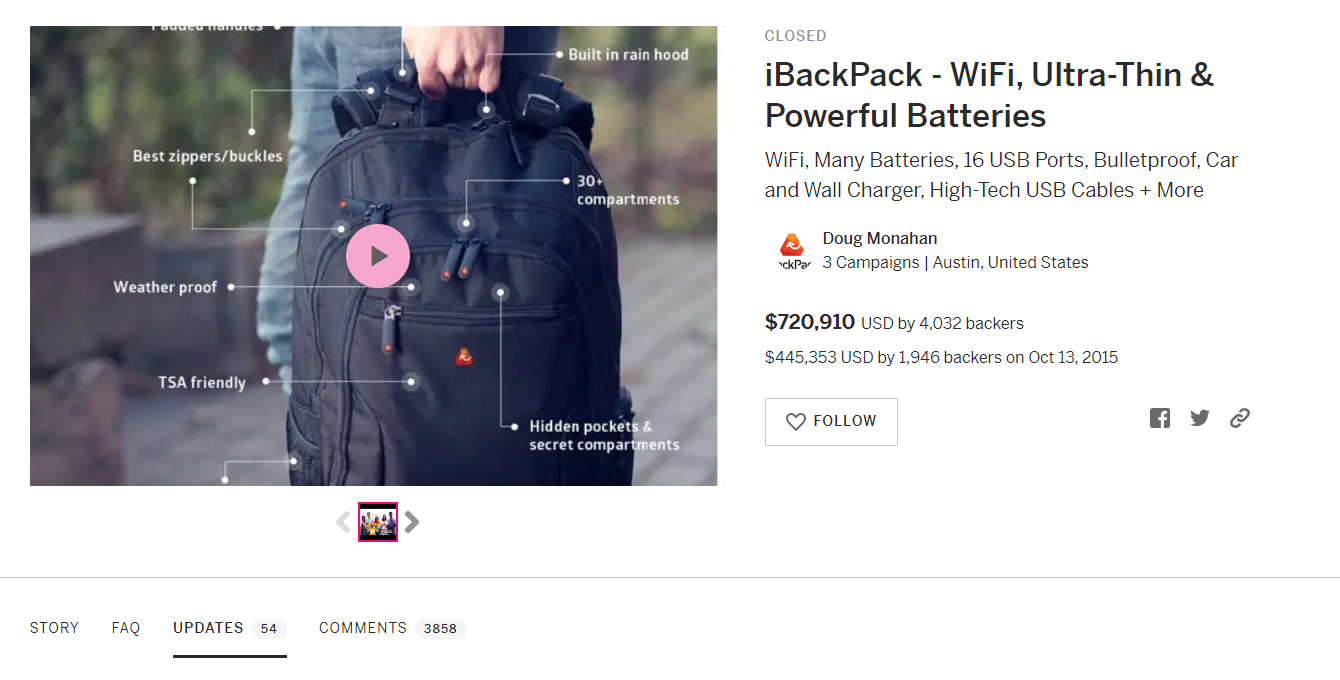
At first glance, it looks like this campaign’s creators went to great lengths to keep good communication with their backers. 54 updates is a good indication that they put a lot of energy into keeping everybody informed and up-to-date. But as we’ve touched on, quantity is not as important as being fully transparent to those who have pledged.
In the end, they were unable to follow through with the promise of their campaign, and subsequently cut all communication with customers and shut down all social media channels. If there’s one big takeaway from that, it’s that you should always avoid going radio silent for significant stretches of time, and you should try to avoid shutting down any channels if you can help it. These are two of the quickest ways to set off red flags within your community, which will have vigilant backers flocking to confirm whether they have been scammed out of their money or not.
Conclusion
Think about the last time you bought something on Amazon. Did you get a personalized message from the vendor? Did you feel confident you’d get a prompt response if you needed to reach out for a problem? Most likely not.
This is the crucial difference between other traditional e-commerce transactions and crowdfunding. Kickstarter and Indiegogo backers are looking to become part of a brand, not just buy something and never think about it again. It’s vital, as the creator, to utilize good communication to stay connected with your audience post-campaign.
Recap of essential dos and don’ts
The dos:
- Keep replying to all questions, comments, and concerns.
- Be consistent with your voice and frequency.
- Be creative in how you communicate.
- Have a plan before you get to post-campaign communication.
- Be flexible when things inevitably go wrong.
The dont’s:
- Don’t neglect platform updates and how streamlined they can make your communication.
- Don’t have long pauses in communication or else backers will think the worst.
- Don’t give backers false hope or promise what you aren’t sure you can deliver.
- Don’t forget to add a personal touch and show your gratitude.
Final thoughts on effective communication
At the end of the day, it’s all about putting yourself in the backer’s shoes. Ask yourself: If I put my money down on a product that doesn’t exist yet, what would I want the creator to do to put my mind at ease until receiving said product?
Keep the key principles of this post in mind, and apply your own good sense to communicate most effectively to your audience. You’ll learn a lot as you go along, and you’ll develop a good grasp of how your backers are as your crowdfunding journey progresses. Exercise good communication to connect with this audience, and you’ll see how this community can help your business grow in the future.
Further resources
For more resources on all things crowdfunding, check out the rest of the LaunchBoom blog for insights and insider tips. And if you’re worried about the post-campaign stretch of your crowdfunding journey, don’t worry — we understand.
Don’t hesitate to fill out a form below to schedule a chat with one of our product launch experts, and we’ll be happy to guide you all the way through to successful product fulfillment.
Further reading on crowdfunding strategies
If you’d like to read more on crowdfunding strategies, check out Crowdfunded by LaunchBoom CEO, Mark Pecota. This comprehensive deep dive from one of the most trusted names in crowdfunding will help you navigate the product launch process from start to finish.




